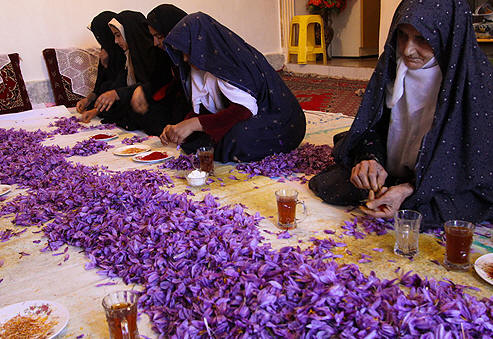Fun Facts:
What You Didn't Know...
Saffron is quite an interesting plant. It has been an important and extremely precious spice for thousands of years and continues to be a prevalent organism today as well. Due to its rich color, flavor, scent, and time spent harvesting it, saffron has been revered throughout our world's history leading into the present day. Whether it be a cultural, economic, or scientific purpose, it is clear Crocus sativus never seems to lose its significance.
Cultural/ Historical Facts:
- In ancient India, robes were traditionally dyed
a golden color from the crocin chemical dye that is
found in saffron. In fact, after
Buddha had
died, the Buddhist priests made this
 golden saffron
color their official color of their robes.
golden saffron
color their official color of their robes.
- The crocin dye found in Crocus sativus has been used in several cultures to dye royal garments.
- Saffron used to be used by Greek courtesans (prostitutes for the royals and wealthy men) as a perfume on behalf of its pleasant aroma.
- Cleopatra used to use saffron as a type of cosmetic. (Another type of organism that can be used for cosmetic purposes is the Medicinal Leech.)
- In the Middle Ages, one could be sentenced to the punishment of being buried alive if they tried to alter saffron by adding in other substances. This would make the saffron not pure, but unknown to others, mixed with other materials to increase the quantity and weight of the substance. Therefore the seller would illegally make more money off of the saffron.
- Romans used to take baths infused with saffron.
- In order to cure hang-overs, Romans would sleep with expensive pillows that were stuffed with saffron.
Economic Facts:
- It takes about 75,000 crocus flowers to make one pound of saffron spice.
- 4,500 crocus flowers make up one ounce of saffron spice.
- Saffron can cost up to $315/oz. to $5,040/lb.
- Elderly women are usually given the job of
removing
 the saffron stigmas from the crocus flowers, a very
strenuous job, because there are no machines that
can separate these three delicate stigmas from the
flower.
the saffron stigmas from the crocus flowers, a very
strenuous job, because there are no machines that
can separate these three delicate stigmas from the
flower. - A little bit of saffron (a couple of threads to a pinch) can truly go a long way since this little amount can be enough to color and flavor an entire meal.
Continue to References.
Return to Homepage Go to MultipleOrganisms.net
